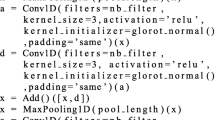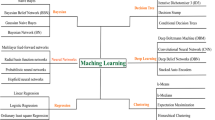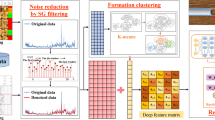Abstract
Resistivity inversion plays a significant role in recent geological exploration, which can obtain formation information through logging data. However, resistivity inversion faces various challenges in practice. Conventional inversion approaches are always time-consuming, nonlinear, non-uniqueness, and ill-posed, which can result in an inaccurate and inefficient description of subsurface structure in terms of resistivity estimation and boundary location. In this paper, a robust inversion approach is proposed to improve the efficiency of resistivity inversion. Specifically, inspired by deep neural networks (DNN) remarkable nonlinear mapping ability, the proposed inversion scheme adopts DNN architecture. Besides, the batch normalization algorithm is utilized to solve the problem of gradient disappearing in the training process, as well as the k-fold cross-validation approach is utilized to suppress overfitting. Several groups of experiments are considered to demonstrate the feasibility and efficiency of the proposed inversion scheme. In addition, the robustness of the DNN-based inversion scheme is validated by adding different levels of noise to the synthetic measurements. Experimental results show that the proposed scheme can achieve faster convergence and higher resolution than the conventional inversion approach in the same scenario. It is very significant for geological exploration in layered formations.











Similar content being viewed by others
Data availability
The data used in this work are available from the corresponding author (gao.muzhi@upc.edu.cn).
References
Colombo, Alyaev S, Shahriari M, Pardo D, Omella AJ, Larsen DS, Jahani N et al (2021a) Modeling extra-deep electromagnetic logs using a deep neural network. Geophysics 86(3):E269–E281
Colombo D, Turkoglu E, Li W, Sandoval-Curiel E, Rovetta D (2021b) Physics-driven deep-learning inversion with application to transient electromagnetics. Geophysics 86(3):E209–E224
Hao P, Sun X, Nie Z, Yue X, Zhao Y (2022) A robust inversion of induction logging responses in anisotropic formation based on supervised descent method. IEEE Geosci Remote Sens Lett 19:1–5
Hardman RH, Shen LC (1986) Theory of induction sonde in dipping beds. Geophysics 51(3):800
Heriyanto M, Srigutomo W (2017) 1-D DC resistivity inversion using singular value decomposition and levenberg-marquardt’s inversion schemes. In: Journal of Physics: Conference Series, vol 877, No (1), pp 012066
Hu YY, Guo R, Jin YC, Wu XQ, Li MK, Abubakar A et al (2020) A Supervised descent learning technique for solving directional electromagnetic logging-while-drilling inverse problems. IEEE Trans Geosci Remote Sens 58(11):8013–8025
Ioffe, S., and Szegedy, C. (2015). Batch Normalization: Accelerating Deep Network Training by Reducing Internal Covariate Shift. In: International conference on machine learning, pp. 448-456. arXiv preprint arXiv:1502.03167
Jianchang M, Anil KJ (1996) Artificial neural networks: a tutorial. Computer 29:31–44
Li MY, Yue XG, Hong DC, Han W (2015) Simulation and analysis of the symmetrical measurements of a triaxial induction tool. IEEE Geosci Remote Sens Lett 12(1):122–124
Li H, He ZH, Zhang YT, Feng J, Jian ZY, Jiang YB (2022) A study of health management of LWD tool based on data-driven and model-driven. Acta Geophys 70(2):669–676
Liu DJ, Li H, Zhang YY, Zhu GX, Ai QH (2014) A study on directional resistivity logging-while-drilling based on self-adaptive hp-FEM. Acta Geophys 62(6):1328–1351
Liu B, Guo Q, Li S, Liu B, Jiang P (2020) Deep learning inversion of electrical resistivity data. IEEE Trans Geosci Remote Sens 58(8):5715–5728
Noh K, Pardo D, Torres-Verdin C (2022) 2.5-D Deep learning inversion of LWD and deep-sensing em measurements across formations with dipping faults. IEEE Geosci Remote Sens Lett 19:1–5
Pardo D, Torres-Verdín C (2015) Fast 1D inversion of logging-while-drilling resistivity measurements for improved estimation of formation resistivity in high-angle and horizontal wells. Geophysics 80(2):E111–E124
Shen QY, Wu XQ, Chen JF, Han Z, Huang YQ (2018) Solving geosteering inverse problems by stochastic Hybrid Monte Carlo method. J Petrol Sci Eng 161:9–16
Raj AS, Srinivas Y, Oliver DH, Muthuraj D (2014) A novel and generalized approach in the inversion of geoelectrical resistivity data using artificial neural networks (ANN). J Earth Syst Sci 123(2):395–411
Shahriari M, Pardo D, Picon A, Galdran A, Del Ser J, Torres-Verdin C (2020) A deep learning approach to the inversion of borehole resistivity measurements. Comput Geosci 24(3):971–994
Shahriari M, Pardo D, Rivera JA, Torres-Verdin C, Picon A, Del Ser J et al (2021) Error control and loss functions for the deep learning inversion of borehole resistivity measurements. Int J Numer Meth Eng 122(6):1629–1657
Shahriari M, Hazra A, Pardo D (2022) A deep learning approach to design a borehole instrument for geosteering. Geophysics 87(2):D83–D90
Singh UK, Tiwari RK, Singh SB (2013) Neural network modeling and prediction of resistivity structures using VES Schlumberger data over a geothermal area. Comput Geosci 52(MAR.):246–257
Tembely M, AlSumaiti AM, Alameri W (2020) A deep learning perspective on predicting permeability in porous media from network modeling to direct simulation. Comput Geosci 24(4):1541–1556
Thiel M, Omeragic D (2017) High-fidelity real-time imaging with electromagnetic logging-while-drilling measurements. IEEE Trans Comput Imaging 3(2):369–378
Veettil DRA, Clark K (2020) Bayesian geosteering using sequential monte carlo methods. Petrophysics 61(1):99–111
Wang GL, Barber T, Wu P, Allen D, Abubakar A (2017) Fast inversion of triaxial induction data in dipping crossbedded formations. Geophysics 82(2):D31–D45
Wang L, Li H, Fan Y (2019) Bayesian inversion of logging-while-drilling extra-deep directional resistivity measurements using parallel tempering markov chain monte carlo sampling. IEEE Trans Geosci Remote Sens 57(10):8026–8036
Xing G, Wang H, Ding Z (2008) A new combined measurement method of the electromagnetic propagation resistivity logging. IEEE Geosci Remote Sens Lett 5(3):430–432
Xu Y, Sun K, Xie H, Zhong X, Hong X (2018) Borehole resistivity measurement modeling using machine-learning techniques. Petrophysics 59(6):778–785
Yadav S, Shukla S (2016) Analysis of k-fold cross-validation over hold-out validation on colossal datasets for quality classification In: IEEE 6th International advance computing conference (IACC), pp 78–83
Yang S, Hong D, Huang WF, Liu QH (2017) A stable analytic model for tilted-coil antennas in a concentrically cylindrical multilayered anisotropic medium. IEEE Geosci Remote Sens Lett 14(4):480–483
Yu X, Efe MO, Kaynak O (2002) A general backpropagation algorithm for feedforward neural networks learning. IEEE Trans Neural Netw 13(1):251–254
Zhang L (2000) Application of neural networks to interpretation of well logs. The University of Arizona, Tucson
Zhang Z (2011) 1-D modeling and inversion of triaxial induction logging tool in layered anisotropic medium. University of Houston, Houston
Zhong L, Jing L, Bhardwaj A, Shen LC, Liu RC (2008) Computation of triaxial induction logging tools in layered anisotropic dipping formations. IEEE Trans Geosci Remote Sens 46(4):1148–1163
Zhu G, Chen X, Kong F, Kang L (2017) A continued fraction method for modeling and inversion of triaxial induction logging tool. In: 2017 IEEE microwaves, radar and remote sensing symposium (MRRS)). pp 210–204
Zhu GY, Gao MZ, Kong FM, Li K (2019) Application of Logging while drilling tool in formation boundary detection and geo-steering. Sensors 19(12):2754
Acknowledgments
This work was supported in part by the National Natural Science Foundation of China, Grant/Award Number: 42174141, in part by the Shandong Natural Science Foundation of China under Grant Number: ZR2021QF132, ZR2022QD082, and in part by the Fundamental Research Funds for the Central Universities of China under Grant Number: 22CX06036A.
Author information
Authors and Affiliations
Contributions
GZ contributed to conceptualization, methodology, writing. MG contributed to conceptualization, methodology, review and editing. BW contributed to validation, supervision.
Corresponding author
Ethics declarations
Conflict of interest
The authors declare that they have no known competing financial interests or personal relationships that could have appeared to influence the work reported in this paper.
Additional information
Edited by Dr. Qamar Yasin (ASSOCIATE EDITOR) / Prof. Gabriela Fernández Viejo (CO-EDITOR-IN-CHIEF).
Rights and permissions
Springer Nature or its licensor (e.g. a society or other partner) holds exclusive rights to this article under a publishing agreement with the author(s) or other rightsholder(s); author self-archiving of the accepted manuscript version of this article is solely governed by the terms of such publishing agreement and applicable law.
About this article
Cite this article
Zhu, G., Gao, M. & Wang, B. A robust inversion of logging-while-drilling responses based on deep neural network. Acta Geophys. 72, 129–139 (2024). https://doi.org/10.1007/s11600-023-01080-x
Received:
Accepted:
Published:
Issue Date:
DOI: https://doi.org/10.1007/s11600-023-01080-x




